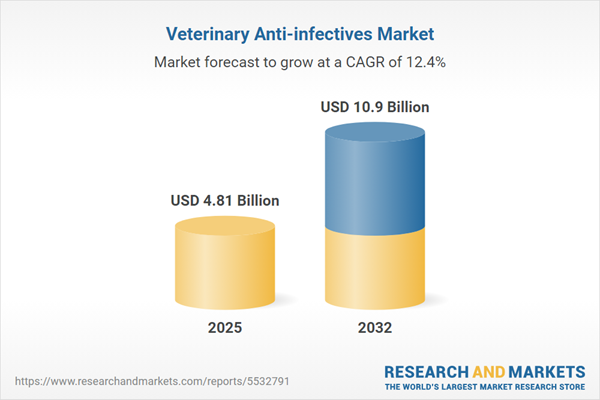Speak directly to the analyst to clarify any post sales queries you may have.
The veterinary anti-infectives market is navigating a transitional period driven by technological advances, regulatory reforms, and shifting stakeholder expectations. As industry players strive to address antimicrobial resistance, the demand for innovative, safe, and sustainable solutions is steadily rising.
Market Snapshot: Veterinary Anti-infectives Market Growth and Landscape
The global veterinary anti-infectives market grew from USD 4.28 billion in 2024 to USD 4.81 billion in 2025. It is projected to expand at a CAGR of 12.38%, reaching USD 10.90 billion by 2032. This robust trajectory reflects the sector’s role at the intersection of animal health innovation, regulatory oversight, and the intensification of farming and companion animal care. Strategic focus is increasingly on stewardship, digital transformation, and resilient sourcing across markets including the Americas, Europe, Middle East & Africa, and Asia-Pacific.
Scope & Segmentation: Veterinary Anti-infectives Market Analysis
- Product Types: Antibiotics (aminoglycosides, beta-lactams, fluoroquinolones, macrolides, sulfonamides, tetracyclines), antifungals (azoles, polyenes), and antiparasitics (acaricides, anthelmintics, insecticides).
- Routes of Administration: Injectable (intramuscular, intravenous, subcutaneous), oral (pellets, powders, suspensions, tablets), and topical (creams, dips, ointments, sprays).
- Animal Categories: Aquaculture (fish, shrimp), companion animals (cats, dogs), livestock (cattle, goats, sheep, swine), and poultry (chicken, turkey).
- Distribution Channels: Online pharmacies, retail pharmacies, veterinary clinics, veterinary hospitals.
- Applications: Prophylactic (prevention) and therapeutic (treatment) uses.
- Regions Covered: Americas (United States, Canada, Mexico, Brazil, Argentina, Chile, Colombia, Peru), Europe, Middle East & Africa (United Kingdom, Germany, France, Russia, Italy, Spain, Netherlands, Sweden, Poland, Switzerland, United Arab Emirates, Saudi Arabia, Qatar, Turkey, Israel, South Africa, Nigeria, Egypt, Kenya), Asia-Pacific (China, India, Japan, Australia, South Korea, Indonesia, Thailand, Malaysia, Singapore, Taiwan).
- Key Industry Players: Zoetis Inc., Elanco Animal Health Incorporated, Merck & Co., Inc., C.H. Boehringer Sohn AG & Co. KG, Intas Pharmaceuticals Ltd., Ceva Santé Animale SA, Vetoquinol SA, Eco Animal Health Group PLC, Virbac SA, Sequent Scientific Ltd.
Key Takeaways and Strategic Insights
- Advancements in molecular diagnostics and biologic therapies are accelerating earlier pathogen detection and treatment outcomes for both livestock and companion animals.
- Digital tools are enhancing real-time surveillance of antimicrobial resistance, driving data-driven stewardship and more tailored therapeutic protocols.
- Regulatory frameworks are increasingly emphasizing transparent reporting, tighter residue thresholds, and collaborative "one-health" initiatives to unify veterinary and public health objectives.
- Manufacturers and distributors are innovating around product formulations, delivery methods, and value-added services to stay aligned with evolving end-user requirements.
- Market segmentation across diverse animal categories and administration routes allows industry players to target specialized needs, expanding addressable markets and reinforcing operational flexibility.
Tariff Impact on Global Supply Chains
The 2025 United States tariff regime has introduced new cost and supply chain complexities for anti-infectives. Increased import duties on pharmaceutical ingredients are impacting domestic production costs and prompting companies to optimize sourcing, logistics, and contract strategies. Businesses are responding by diversifying manufacturing hubs and leveraging forward contracts to insulate against pricing volatility.
Methodology & Data Sources
This report is underpinned by an integrated research methodology combining primary interviews with veterinary stakeholders, practitioners, and supply chain specialists, with comprehensive secondary research from peer-reviewed publications and industry sources. Rigorous quantitative analyses and qualitative assessments provide reliable data and actionable insights.
Why This Report Matters
- Enables informed strategic decision-making by highlighting critical opportunities and risks in a rapidly evolving veterinary anti-infectives landscape.
- Delivers in-depth segmentation to help senior leaders target growth areas and allocate resources for optimal return.
- Outlines practical recommendations for enhancing resilience amid regulatory changes and supply chain pressures.
Conclusion
The veterinary anti-infectives market is poised for continued innovation and expansion. Future success will depend on technology adoption, adaptive strategies, and cross-sector collaboration to meet the evolving needs of animal health and global food systems.
Additional Product Information:
- Purchase of this report includes 1 year online access with quarterly updates.
- This report can be updated on request. Please contact our Customer Experience team using the Ask a Question widget on our website.
Table of Contents
3. Executive Summary
4. Market Overview
7. Cumulative Impact of Artificial Intelligence 2025
Companies Mentioned
The companies profiled in this Veterinary Anti-infectives market report include:- Zoetis Inc.
- Elanco Animal Health Incorporated
- Merck & Co., Inc.
- C.H. Boehringer Sohn AG & Co. KG
- Intas Pharmaceuticals Ltd.
- Ceva Santé Animale SA
- Vetoquinol SA
- Eco Animal Health Group PLC
- Virbac SA
- Sequent Scientific Ltd.
Table Information
| Report Attribute | Details |
|---|---|
| No. of Pages | 182 |
| Published | October 2025 |
| Forecast Period | 2025 - 2032 |
| Estimated Market Value ( USD | $ 4.81 Billion |
| Forecasted Market Value ( USD | $ 10.9 Billion |
| Compound Annual Growth Rate | 12.3% |
| Regions Covered | Global |
| No. of Companies Mentioned | 11 |









